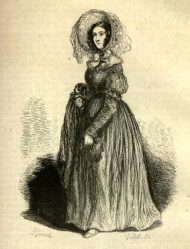
The Old Maid
THE HUMAN COMEDY – Honoré de Balzac Seventh volume of works of Honoré de Balzac edited by widow André Houssiaux, publisher, Hebert and Co, successors, 7 rue Perronet – Paris (1877) Scenes from provincial life 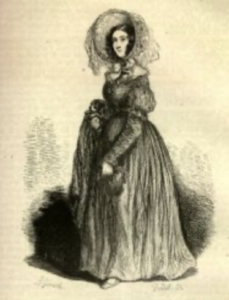 Rose Cormon
Rose Cormon
THE OLD MAID Signed, A MONSIEUR EUGENE-AUGUSTE-GEORGES-LOUIS MIDY DE LA GRENERAYE SURVILLE INGENIEUR AU CORPS ROYAL DES PONTS ET CHAUSSEES As a token of his brother-in-law’s affection, De Balzac. Balzac’s life in 1836 –
Analysis of the work La Vieille Fille (The Old Girl) is a short story Balzac wrote in 1836, when he had just gone through one of the most dramatic phases of his eventful life. Indeed, in July and August 1836, a series of unfortunate events befell him, including the death of Mme de Berny, the bankruptcy of his journal The Paris chronicle. The liquidation of this daily newspaper was for him a disaster on the same scale as the bankruptcy of his printing works in 1828. At the time, his publisher took him to court and sentenced him to a hefty penalty payment, which he described as “a second Berezina”. A new publisher buys out his contracts, his tailor lends him money, a printer offers him his savings. To keep his head above water and forget his worries, Balzac takes a trip to Italy with a new friend, Caroline Marbouty, disguised as a page, whom the Italians mistake for George Sand. On his return, Balzac found himself back in debt, and in order to pay off the larger installments, he set to work, frantically writing in one night one of the tales from On Catherine de MediciIn one night, the second part of a great short story, The cursed child, and in three nights The old girl. At least, that’s what he wrote to Madame Hanska on December 1.er October 1836, adding: “It’s my Brienne, my Champaubert, my Montmirail, it’s my French campaign”. And on October 23, La Vieille Fille began to appear as a serial in La Presse, Emile de Girardin’s daily newspaper. “This is one of Balzac’s greatest and most beautiful novels,” wrote one critic in 1838. It’s neither one of Balzac’s greatest novels in any sense of the word, nor one of his most beautiful,” wrote critic Paul Souday, then literary critic of Le Temps, “and even materially, it’s a bit short. Balzac had come to Alençon in 1825 to meet an engraver who was to work on his editions of Molière and La Fontaine. He crossed Alençon a second time in 1828 on his way to Fougères in Brittany. He remembered the place. They were more or less identifiable in 1886, when M.G. de Contades wrote his article Balzac Alençonnais in a review of the Orne region. But that was all Balzac had seen of Alençon. In reality, Miss Cormon’s boston regulars are drawn from an even more distant pool, even further removed from the century and the highways. Balzac had met them during a stay in Fougères with one of his father’s friends, General de Pommereul. Another local scholar, Monsieur de Pontavice du Heussay, a contemporary of Monsieur de Contade, was able to rediscover in Fougères in 1885, the barely faded memory of the boston players Balzac brought together in Mlle Cormon’s hospitable salon, whom he had actually met at the home of a friend of the Pommereuls, Mlle de la Gesmeraie.
The story In fact, La Vieille Fille, écrite si vite is actually a kind of “fabliau”. Nothing happens, except for a misunderstanding that turns into a comedy. Mlle Cormon is a good, fat girl from Normandy whose celibacy weighs heavily on her and gives her puffs of steam. In his beautiful bourgeois home, people from good families come to play boston. Evenings are pleasant here. Mlle Cormon dreams of getting married – she thinks highly of herself and believes that no one in Alençon is worthy of her. Rose’s entourage includes two suitors: the Chevalier de Valois, an old beau who claims to be related to the kings of France, and who has retained the dress and manners of the Ancien Régime. The other suitor is Monsieur du Bousquier, a former agioteur whose fortune is one of the largest in the region. Both covet Rose Cormon’s hand in marriage, the first for her fortune, the second for the respectability she could bring him. The two contenders wage a merciless war. These two characters are joined by a third, the young Anasthase Granson, much younger than Rose and genuinely in love with her. In need of love, proud and haughty, she nevertheless sets her sights on a forty-something officer, the Viscount de Troisville, who asks to stop off at her home. She believes he’s in love with her, and thinking he’s come to ask for her hand, learns abruptly that he’s married, and that he’s talking to her as a source of information about Alençon housing for his family back in Paris. Having anticipated and boasted to the whole of Alençon of this gentleman’s marriage intentions towards her, she fainted with disappointment and shame and, fearing the next day to be the laughing stock of the villagers, announced her marriage to du Bousquier, the first of her suitors. It’s not a happy ending, as Mlle Cormon has made the wrong choice, is unhappy and confesses some sad secrets. That’s the whole plot, and it’s almost nothing. Paul Souday has a point, but fans of La Vieille Fille don’t either. To begin with, it was the “fabliau” aspect that caused a stir. It was the first time a novel had been serialized in a daily newspaper. Now, whether by design or inadvertence, Balzac had made his good lady’s sighs a little too perceptible, a few details were indiscreet, and the marital disappointment, in the end, a little too clearly described. What about confidentiality and privacy? Readers protested – but what were their objections worth? Recent Balzacians, Pierre-Georges Castex and, after him, Nicole Mozet, have shown that Balzac had little right to complain about this interpretation of his short story. Girardin, prudent deferred his plans to collaborate with Balzac for some time. What Paul Souday didn’t feel – it’s the nostalgic charm that Balzac made into a little music that can be heard in the background. Although comical, this short story is touching. The inhabitants represent a small society that geographically lives away from the main road, which will disappear when the road to Paris is built. This secluded life evokes a kind of archaic happiness, where life is simple and routine. An entrenched place of natural life preserved from the vicissitudes of history. 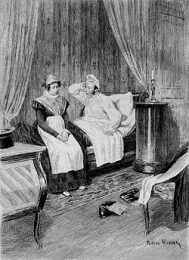 Paris – October 1836
Paris – October 1836
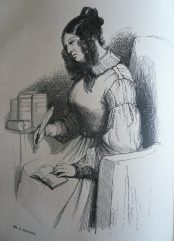
Miss Rose Cormon
The characters Mlle Cormon: Rose-Marie-Victoire, born in 1776, the daughter of a nobleman, is convinced she is in love with an officer. She announced her forthcoming marriage to the nobility of Alençon, even though the object of her thoughts had not declared himself. She then learns that he is married, has a family and is, in fact, only friendly towards her. So as not to lose face with the world, she hastily accepts the marriage proposal from du Bousquier, a crass opportunist who sees the marriage as a useful stepping stone to his career.
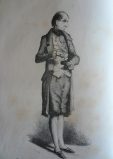
Le chevalier de Valois
Le Chevalier de Valois: Poor gentleman living on 600 pounds of rent. Accepted by the provincial aristocracy, a man of excellent manners and good company. One of Miss Cormon’s suitors.

Du Bousquier
Du Bousquier: From an old Alençon family, Du Bousquier is somewhere between a bourgeois and a hobereau. From 1793 to 1799, Du Bousquier was a food contractor for the French armies. He led the scandalous life of war and chaos, with stolen rations, sacks of wheat harvested without effort; small houses full of mistresses, beautiful parties for the directors of the republic. Citizen Du Bousquier was a close friend of Barras. He was at his best with Fouché, very good with Bernadotte, and aimed for the post of minister with the party that was secretly plotting against Bonaparte all the way to Marengo. With the victory at Marengo and the defeat of the Austrians. The alternative of millions to be made from the defeat at Marengo, and thus the downfall of his party (traitors to the Emperor he worked for), left him almost bankrupt from all his past excesses. Only the liquidation of its receivables from the State allowed it to keep some hope alive. Despite his corrupting gifts, he met with Napoleon’s hatred of the suppliers (including Du Bousquier) who had gambled on his defeat. Du Bousquier found himself penniless. The immorality of his private life, and this supplier’s liaisons with Barras and Bernadotte, displeased the First Consul even more than his stock market maneuvers: he struck him off the list of receivers general. From his opulence, Du Bousquier retained twelve hundred francs in life annuities entered in the ledger. This man ruined by the First Consul, and wearing the etiquette of the colossal reputation of his relations with the heads of past governments, his lifestyle, his fleeting reign interested the town of Alençon where royalism secretly dominated. Du Bousquier furious with Bonaparte (whom he had betrayed and robbed). Pursued by his scandalous and treacherous past, Du Bousquier was not received by the noble families of Alençon, and was refused by Mlle Armande, sister of one of the city’s most respected nobles – and the home of the Chevalier de Valois. Le vicomte de Troisville: A squadron leader under Louis XV, married with children, his feelings for Mlle Cormon are purely friendly.
Sources: 1) Preface (Tome X) based on the complete text of the Comédie Humaine published by France Loisirs 1986 under the auspices of the Société des Amis d’Honoré de Balzac.
2) Further information: Wikipedia universal encyclopedia.
No Comments